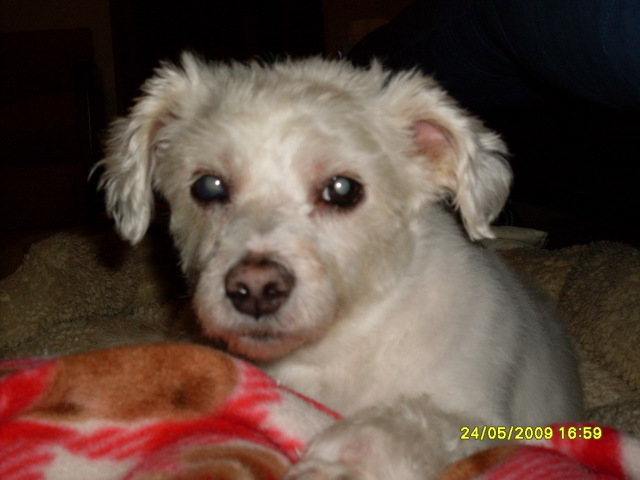Questionhello, I heard cats &/or dogs don't see in "color"-only black & white. is that true? do other animals not have "color" vision(that you know of)? thanks for your time.
AnswerHello Sean -
Dogs can see in much dimmer light than humans. This is because the central portion of a dog's retina is composed primarily of rod cells that "see" in shades of gray while human central retinas have primarily cone cells that perceive color. The rods need much less light to function than cones do. Dogs can detect motion better than humans can. Dogs can see flickering light better than humans. The only significance to this appears to be that dogs may see television as a series of moving frames rather than as a continuous scene. Dogs do not have the ability to focus as well on the shape of objects (their visual acuity is lower).
An object a human can see clearly may appear to be blurred to a dog looking at it from the same distance. A rough estimate is that dogs have about 20/75 vision. This means that they can see at 20 feet what a normal human could see clearly at 75 feet. Dogs are said to have dichromatic vision -- they can see only part of the range of colors in the visual spectrum of light wavelengths. Humans have trichomatic vision, meaning that they can see the whole sprectrum.
Dogs probably lack the ability to see the range of colors from green to red. This means that they see in shades of yellow and blue primarily, if the theory is correct. Since it is impossible to ask them, it is not possible to say that they see these colors in the same hues that a human would. Whether or not the ability to see some color is important to dogs or not is hard to say.
The eyes of dogs and cats have many of the modifications typically seen in animals which evolved as nighttime hunters. The pupil functions much as the aperture for a camera and can dilate for maximal light capturing ability in dogs and cats. In addition, there is a reflective layer under the retina called the tapetum which serves to intensify vision in dim light. The "mirror" effect of the tapetum results in the "eye shine" observed when an animal looks into a car's headlights. While dim light vision is enhanced by the tapetum, scattering of the reflected light may result in reduced acuity.
I hope this information has helped you.
If you would like information on natural and herbal remedies for human and animal concerns please contact me at wintersaurora@yahoo.com and I will happy to assist you and send you a catalog of my home made herbal remedies.
Thank you and best wishes.
Sincerely,
Sharon Hubbs, AHG
Certified Natural Health Consultant & Herbalist

 Diabetes, Cataracts and Glaucoma
Question
My Baby
I have a 11 and 1/2 year old Maltese x
Diabetes, Cataracts and Glaucoma
Question
My Baby
I have a 11 and 1/2 year old Maltese x
 Alternative Med for Tramadol and Metacam
QuestionI need to find a less expensive pain therapy fo
Alternative Med for Tramadol and Metacam
QuestionI need to find a less expensive pain therapy fo
 OVERWEIGHT TOY POODLE
Question
xmas
One of my toy poodles is overweight
OVERWEIGHT TOY POODLE
Question
xmas
One of my toy poodles is overweight
 American Staffordshire with rash - very itchy!
QuestionHi Marie:
My Petey, who just turned seven is a
American Staffordshire with rash - very itchy!
QuestionHi Marie:
My Petey, who just turned seven is a
 Maltese with severe tearing/licking/allergies
QuestionHi Marie!
Daisie, our 8 y/o F/S Maltese weighi
Maltese with severe tearing/licking/allergies
QuestionHi Marie!
Daisie, our 8 y/o F/S Maltese weighi